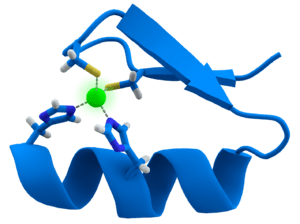Zinc finger facts for kids
Zinc finger nucleases (or ZFNs) are special tools used by scientists. They help to change or "edit" DNA in living things. Think of them like tiny, precise scissors that can cut and change specific parts of a gene. This is one way scientists can make changes to an organism's entire set of DNA, called its genome.
ZFNs have two main parts that work together. The first part is called a zinc finger. These are tiny structures made of a protein and a zinc atom. Each zinc finger is designed to find and stick to a very specific spot on a DNA strand. The second part of a ZFN is an enzyme called Fokl. This enzyme is like the cutting blade of the scissors. When a zinc finger finds its target DNA, the Fokl enzyme cuts the DNA in two places. After the cut, the cell's own repair system fixes the broken DNA. Sometimes, this repair process removes a small piece, or adds a new piece, changing the gene.
Each ZFN is made to work on a single, specific gene. This gene is often called the "target gene." Scientists can design ZFNs to make exact changes to genes. These changes are called mutations. They can be things like removing a piece of DNA (a deletion) or adding a new piece (an insertion). By making these changes, scientists can learn what different genes do. For example, they might change a gene in an animal to see how that change affects the animal.
How ZFNs Work
A "zinc finger" is a name for many different protein shapes. The zinc atom helps these proteins stay strong and stable. ZFNs are designed to stick to specific pairs of DNA building blocks, called base pairs. One zinc finger can usually stick to about three base pairs by itself.
Parts of a ZFN
Zinc finger nucleases are usually made with 3 to 6 zinc fingers. Each ZFN has two important sections:
- A DNA-binding part: This is the zinc finger part. It finds and sticks to a specific DNA sequence.
- A DNA-cleavage part: This part uses the Fokl enzyme. It is the "cutting" part that breaks the DNA.
ZFNs can only change DNA sequences they are designed for. The DNA-binding part makes sure the ZFN goes to the correct spot. To change one gene, two ZFNs are usually needed. These two ZFNs attach to both sides of the DNA's double helix. Then, their DNA-cleaving parts work together to cut the DNA strand. Cells naturally fix broken DNA using their own DNA repair systems. If some base pairs are missing after the repair, it creates a deletion mutation.
Scientists can also choose how long the target DNA sequence should be. For example, they can change as few as 9 base pairs using 3 zinc fingers. This is helpful for removing or adding very short DNA pieces. It helps them understand what these small changes do to the gene. Larger DNA sections can also be changed by using more than one ZFN.
Using ZFNs in Research
ZFNs have been very useful in studies to find out what different genes do. They can be used to change DNA in almost any living thing. Another great thing about ZFNs is that they can be used in vivo. This means they can make changes directly inside living organisms. They are often used in "model organisms" like plants, insects, and fish. These are organisms that scientists study to learn about biology.
Here are some of the organisms where ZFNs have been used to change genes:
- Arabidopsis (a small flowering plant)
- Cattle
- C. elegans (a tiny worm)
- Corn
- Drosophila melanogaster (fruit flies)
- Frogs
- Mice
- Pigs
- Rabbits
- Rats
- Sea urchins
- Silkworms
- Soybeans
- Tobacco
- Zebrafish
Challenges with ZFNs
One of the biggest challenges with ZFNs is making sure they only change the target gene. Sometimes, they might accidentally change other genes too. A ZFN must be designed very carefully to find only the right base pairs on the target gene. These specific base pairs are chosen so that only the target gene has them. The DNA-cleavage part of the ZFN can cut any DNA. So, if the ZFN accidentally sticks to the wrong gene, it will cut that gene instead. ZFNs that change more than one gene are not considered accurate.
See also
 In Spanish: Dedo de cinc para niños
In Spanish: Dedo de cinc para niños


